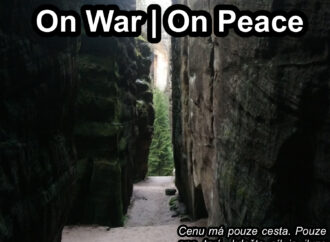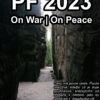Author of this text Martin Svárovský is a historian and diplomat. He is currently working on Czech Ministry of Foreign Affairs. The opinions expressed in this article are the author’s own and do not reflect the view of the Czech ministry of Foreign affairs.
“I believe the letter of any law is always derived from its sense and its spirit. When the law is applied, these are what it must be measured against.”
Václav Havel
November last year, President Donald Trump, in consultation with his national security team, has approved a new strategy on Iran (hereinafter referred to as “Iran-strategy”). It was the culmination of nine months of consultations with the Congress and US allies on how to tackle the issue. The following article is not going to provide many details on Iran but rather elaborate on the implication of the Iran-strategy for trans-Atlantic relations which also has its meaning for the Czech foreign policy.
General context
As a first step of the new Iran-strategy, the Trump administration refused to certify Iranian compliance with the international agreement on the Iranian nuclear program reached in the format “E3/EU+3 and Iran” on 14 July 2015, known as Joint Comprehensive Plan of Action (JCPOA). At the same time the president asked the Congress to work out a mechanism that allows imposing new “nuclear sanctions” against Iran in case some redlines would be crossed.
The president said that Iran is breaching the letter and the spirit of the agreement. Well, we may debate whether and how is it possible to be in clash with the spirit but several facts cannot be denied. Iran has been playing a role in every regional conflict through proxy activities, strengthening its military power, trying to build a corridor across Iraq and Syria all the way to Lebanon (and thus “breaking the wall” built between Iran and Lebanon by the US intervention in Iraq) and aiming to seize control over Iraqi and Jordan borders with Syria.
Relevant and reliable information sources clearly pointed out that Iran is using additional financial means generated by the implementation of the JCPOA, for instance through renewed access of Iranian oil to international markets, to further increase military spending, including on ballistic missile research and testing. Thus Iran has been able to achieve progress in terms of range of its missiles. The fact that ballistic and cruise missiles currently developed by Iran could become “nuclear capable” represents a grave problem. This is in breach with the UN resolution 2231, which calls for Iran to refrain from activity related to nuclear-capable missiles. All these activities endanger stability of the region and can be described as anything but peaceful.
Perhaps the most notable feature of the US Iran-strategy is that it covers the entirety of Iran’s behavior, not just the fields covered by JCPOA. Apart from topics which attract attention of the international community (proxy activities, ballistic program, nuclear program, terrorism), the Iran-strategy is directing attention to other specific elements such as: oppression of Iranian people and abuse of their rights, threatening freedom of navigation, especially in the strategically vital Persian Gulf or refusing to allow inspections of Iranian military sites by the International Atomic Energy Agency (IAEA).
Special attention in the Iran-strategy is dedicated to the Islamic Revolutionary Guard Corps (IRGC) whose task is to defend the Islamic Republic system and which receives up to 50% of the Iranian defense budget. The IRGC might be the target of a new, tougher approach including tailor-made sanctions. This is very important since the IRGC controls up to one third of the Iranian economy through affiliated companies.
While assessing justification of the Iran-strategy, it is important to consider the complexity of the situation and the high level of interdependency in the region. Iran’s activities in Syria (Iran has maintained a strong presence in the country – IRGC, IRGC-QF and Shia militias – since the start of the conflict and is likely to keep it there in longer perspective), Lebanon and Iraq (Iran supports the Shia population, controls powerful Shia militias and casts leverage on the Shia-dominated Iraqi central government) have an impact on the entire Middle East. They are clearly in clash with interests of Saudi Arabia, Egypt and Israel.
Some consequences of the Syrian crisis with Iran being a substantive player therein are of permanent nature. Syrian refugees in Jordan or Lebanon have irreversibly changed the demographic composition of these countries. The interdependency goes much further. The situation in the Middle East has, through the involvement of major world powers, an impact on the global policy. Look at the Russia-Iran cooperation in Syria or the Russian hypersonic missiles and potentially also tactical nuclear weapons placed in the Syrian base in Latakíja.
The danger of a nuclear spillover also has a global dimension. If Iran, a country with huge military forces, gains the military nuclear capability, Saudi Arabia may seek Pakistan to provide it with the same. Pakistan might be willing to do so in order to gain, through placement of its weapons in Saudi Arabia, second strike capability against India.
It is important to keep in mind that the Iran-strategy and relevant expert sources state that the ultimate goal of the Iranian regime is to protect the achievements of the Islamic revolution. It means the activities of the regime inside as well as outside of the country have a standing, structural character. Accordingly, the reaction to it must be genuine, comprehensive and strategic.
Common argumentation of supporters of JCPOA is that its implementation serves the moderate forces inside Iran. This argumentation sounds logical, the aim of the international community should indeed be support of the moderates. But it has some weak points. First of all, the relief of considerable part of sanctions against Iran after implementation JCOPA most of all serves the interest of both, moderates as well as hardliners. Secondly, the conservative forces are strong enough and the idea of moderates gaining superiority in Iran is an illusion. The conservatives have kept enough influence in the Parliament and the Assembly of Experts – the body in charge of electing and dismissing the Supreme leader (ayatollah). The ruling system of Iran has effective mechanisms to preserve the Supreme Leader’s will and thus no significant changes in Iran´s internal politics can be expected in the short term. Moreover, president Rouhaní’s economic reform plans have little chance, taking into account the decisive position of the IRGC and ayatollah Khamenei in the country’s economy.
Overall, if the US wants to succeed in pushing back Iran’s regional aggressive appetite, much will depend on its ability to cooperate with its allies in advancing these goals. Here, Minister Tillerson’s clarifications were crucial in explaining, despite prevailing media analysis, that Trump’s administration is not seeking to get rid off the deal, at least in the short term, or to go to war. The stated aim is to strengthen the deal, and restore US deterrence vis-à-vis the Iranian regime and the IRGC. In January, President Trump announced the prolongation of the freeze agreeing to waive key sanctions the US lifted as part of the deal. But Trump gave a warning in a statement that the waiver — which must be issued every 120 days to keep the sanctions from kicking back in – will be the last he issues and delivered a stark ultimatum to European allies on Friday: “Fix the deal’s disastrous flaws, or the United States will withdraw.”
Importance of the Iran-strategy for the US foreign policy
Iran has played an important role in the US foreign policy for decades (US support for Reza Pahlavi’s regime, Lebanon hostage crisis, Iran-Contra affairs). The raising gravity of the issue could have also been observed from the expressions of Donald Trump prior and right after the presidential election. After the new administration was established, the month-length discussion among experts as well as with the Congress has started. The process led to the announcement of the new Iran-strategy.
One month later, in December 2017, the new National Security Strategy of the USA was published. In my assessment, the NSS represents a significant change in the US strategic thinking and policy making. The adversaries, rather than terrorism, are in the center of the NSS attention and the US is openly declaring the priority to approach them from the position of strength. Iran has a privileged position in this document. As its two main adversaries are named Russia and China, but other threats, according the NSS, stem from “rogue regimes” like North Korea and Iran.
The NSS points out the Iran support of terrorist groups and its attempts to expand its influence over the Middle East to be the key concern. The seriousness of the Iran issue is also given by the connection between Iran and North Korea which is regarded as the most pressing national security concern. This link is also characterized by the past record of the cooperation of Iran and North Korea in the nuclear field. The NSS highlights the validity and importance of the Iran-strategy.
The United States, being a littoral state, is definitely interested in a problem-free flow of goods which among others requires safety of shipping routes. Therefore, the important element of the US security strategy is the navy. So if Iran-backed Houthis in Yemen (Iran has provided Houthis with weapons and training) endanger freedom of navigation at Bab al-Mandab strait, it becomes a matter of strategic importance for the United States.
The importance of Iran-strategy in the US foreign policy is also influenced by the question to what extent it is supported by the Congress. Even though there might be some differences in the assessment of the efficiency of JCPOA, there is, similarly to the case of Russia, quite solid consensus on a tough stance towards Iran in the Congress. In the House as well as in the Senate there are legislative debates going on about whose aim is to address the shortages of JCPOA (there is a question of checking the military facility or more strict limitation on uranium enrichment).
The need of the US to have partners
The new NSS first names Iran as one of the strategic threats to the US and second, it indicates that the US will seek cooperation with partners on tackling this issue while handling it from the position of strength. By the same token the Iran-strategy says that the US will revitalize the traditional alliances and regional partnerships as bulwarks against Iranian subversion and restore a more stable balance of power in the region. That clearly indicates the Iran-strategy is not meant as unilateral US endeavor but envisages a wide cooperation with partners.
In his end of November speech, minister Tillerson named the Iranian issue one of the US foreign policy priorities. At the same time, he declared that European partners are expected to help the United States with North Korea, to elaborate on common stance towards Iranian threat and commit themselves to continuing the cooperation in Afghanistan. So, the message is clear, the US need their European partners. It can be the EU as a whole. But in order to generate support, there might be also room for sub-regional groupings, where majority of members are receptive to the US stance like the Bucharest Format or the Three Seas Initiative.
Among the European states, the three signatories of the JCPOA are the most important partners of the US on Iran. The UK, a traditional player in the region, has valuable intelligence information from the field (the UK brought the information that the missile shot recently by Houthis on Riyadh was of Iranian origin). British banks are crucial if confidence of foreign investors in Iranian economy is to be restored potentially. France is the most vocal among European countries, in addressing issues outside the JCPOA, in particular Iran’s missile program but also regional aggression. Germany, another signatory is a significant trade partner of Iran. German Chancellor is definitely interested in intensive German-US relations in economic as well as strategic issues. It is in this context that Chancellor Merkel discussed the Iranian issue with British Prime Minister Theresa May. Both agreed that there are issues of concern (destabilizing regional activities of Iran and ballistic missile program) that need to be dealt with.
As for the regional context, multiplication effect to the Iran strategy might come from Israel and Saudi Arabia, which are interested in containing Iran and setting limits to its nuclear potential. In the latter case, the future progress of the Crown Prince’s desire for liberalization of Saudi Arabia will be important. It counts both for US public acceptance of choosing this country as a key ally and maybe even for encouragement of those in Iran who want to liberalize the country.
There are signals that the US is going to generate pressure on other states to embark on the board in this issue. In case of Turkey such a pressure would have only limited impact, taking into account the size of the country and its tendency to handle things independently and with a high amount of assertiveness. The pressure might be more tangible on countries like Azerbaijan. Representatives of this country recently got a message that they have to decide who is more important partner for the country, whether it is the US or Iran.
Importance of cooperation with the EU
All doctrinal documents of the United States, identify Europe as a key ally. According official statements, it applies to Russian aggressive behavior as well as to other global threats, including Iran.
The importance of the EU for the US Iran-strategy is given mainly by the economic power of the EU. Before the nuclear-related sanctions were imposed, the EU was Iran’s main economic partner. Among the European trade and investor partners, France, Germany and Italy are the most prominent. Since the nuclear deal came into force on 16 January 2016, the bilateral trade between the EU and Iran has almost doubled.
The EU member states, together with the European Commission, dominate the so called Financial Action Task Force (FATF), an intergovernmental body, whose objective is to set standards and promote effective implementation of legal, regulatory and operational measures to combat money laundering, terrorist financing and other threats related to the integrity of the international financial system. On the program of FATF there is also an assessment of Iran. The outcome of the assessment will have a crucial impact on the Iranian banking system and its credibility among foreign investors. One may even observe that because trade with traditional European partners is so important for some Iranian politicians, the JCPOA is mainly about trade with Europe.
In this regard, the political weight of the EU cannot be underestimated but it has a rather secondary meaning. It can be expected that the US will keep trying to get the EU on board as a whole. In case this effort brings no results, the US will adjust its approach accordingly. Then it will concentrate on selected European states receptive to the US argumentation.
My point is that the second option is less favorable for the interest of the EU and its CSFP. The EU needs to cut the Gordian knot. It needs to stick to the JCPOA and at the same time it must be ready to increase effective pressure on Iran to cope, at least to some extent, with the US and other Middle East countries’ demands and security concerns. If we read carefully the recent statements of HR/VP Mogherini, there seems to be some room for EU being able to make the cut.
In any case, we might see a whole range of conceptual differences in the EU and the US approach. Some of them are more fundamental, some of them less.
The US strategy on Iran is not just about JCPOA. The imbalance consists in the fact that the EU has built its current Iran policy to big extent on the implementation of the JCPOA. After the agreement was signed, the EU established the “Iran task force” and HR/VP Mogherini became a coordinator of the work of the Joint Commission, which oversees JCPOA implementation. According to the official EU/EEAS document, “the overarching agreed joint objectives” of EU-Iran relations are: „Ensuring and supporting the full implementation of the JCPOA in order to further improve and deepen bilateral cooperation with Iran”. This means that any substantial move in the JCPOA would trigger the need for change of the entire EU “Iran policy”…
What the EU HR/VP says on Iran clearly indicates a strategy of decoupling. She acknowledged that there are other questions concerning Iran but they might be discussed on separate fora than those provided by the JCPOA, which in her interpretation is delivering. According to Ms. Mogherini, in an unstable world like the one today, it is irresponsible to dismantle an agreement that is working and delivering.
The US needs to acknowledge that the promotion of the economic interest of Europe is a legitimate and pragmatic policy. Lifting of sanctions in line with the JCPOA has accelerated trade and economic relations. Trade between the EU and Iran has increased by 94% in the first year of the JCPOA implementation, European foreign direct investments into Iran are on the rise in many sectors including energy, automotive and transportation industries and there are good prospects for solid growth of the Iranian economy.
This impressive increase still might look marginal if we take into account the volume of EU-Iran trade and its share on the entire EU trade with third countries. Nevertheless, in the specific field like energy, these numbers are more significant (oil is the main item of the EU’s import from Iran). In energy field, it is not just the volume what counts but also to what extent the oil import from Iran contributes to the diversification of sources for the EU. Therefore the EU has established a high level dialogue on energy with Iran which tackles the issue of cooperation on fossil fuels as well as electricity, renewable energy and energy efficiency.
Another question is to what extent the interests of Europe and the US overlap? Are they the same and just the approach is different? Or both differ, the approach and the nature of the interest? The picture would be rather complex and would require in-depth analysis that is exceeding the scope of this article. In any case there is a consensus among EU member states that the EU should take more strategic approach towards the entire Middle East, including Iran. Strategic approach may take economic interests of individual member states into consideration, but they should not prevail. If the EU wants to keep JCPOA intact, it must be able to transfer to Iran a credible message that not only the letter but also the spirit of this treaty has to be maintained. The EU’s credibility as a guarantor of the nuclear treaty is at stake. Such a credibility might be important in the future if EU is to face a strategic threat in its vicinity.
The current international environment
No doubt Iran has increased its assertiveness in regional affairs since the signing the JCPOA. The position of relevant international players is shaped by their view on whether Iran still intends to continue the military nuclear program. The common sense tells that after 30 years of development of nuclear weapons, the know-how and expert personnel cannot disappear in a result of just a signature of an agreement. One has to bear in mind Iran’s record of both, past bluffing and use of circumvention tactic to hide nuclear related activities.
After all, even Iranian foreign minister Zaríf confirmed this kind of suspicion in his article in Financial Times. The Minister threatens the West that technologies of nuclear enrichment in possession of Iran are now better than before the signature! (“If we decide to walk away from the deal we would be walking away with better technology.”) Symptomatic is also the message by the representatives of Iran after the last US waiver in January. They excluded that Iran would allow, even under US pressure, an inspection of its military sites! No wonder, even negotiators of JCPOA on expert level admitted that the military sites of Iran are currently not inspected.
If the US is to take the position of strength towards countries like Iran or Russia, the effectivity and results of the Iran-strategy is about the credibility of this latest US strategic approach. It is sort of a litmus test of this approach reflected in the new NSS. The fact that Iran continues its military program and Iranian nuclear scientists are likely to work not only in Iran but also abroad (Iran might have a secret agreement with North Korea on continuing its program on the North Korean territory) cannot be left without proper and tangible response by the US.
There is a substantive clash of two paradigms between the US and the EU: a comprehensive approach (the Trump administration) versus targeted one, based on decoupling (Obama administration and the EU). EU Task Force Iran built up around the JCPOA shows disproportionally higher attention paid to the Agreement in Europe. Still, the transatlantic unity in this strategic issue would be welcomed on both sides of the Atlantic. To achieve that, it requires more understanding for each other’s view. The EU needs to show more understanding for the US argumentation on the threat posed by the Iranian regime and its behavior. It needs to put more emphasis on geo-strategic aspects and to think more in the longer perspective.
Besides the letter and the spirit the JCPOA there is yet another dimension. It is a psychology connected to the mere fact of the EU’s signature under the Agreement. It is natural that the EU regards this as a proof of the weight of its foreign policy. The US should have an understanding for this psychological aspect and the symbolic meaning of the JCPOA for the EU. Psychological and purely political motivation plays a role on both sides, the US (differentiating from Obama administration) and the EU (proving the independence of the EU foreign policy – compare it with the French term “strategic autonomy” in European Common Security and Defence Policy). Both sides need to work with it.
Another collision between different players stems from the differences in their security/strategic posture. Some European countries, like France, are ready to put pressure on Iran because of its ballistic program that is in clash with the 2231 resolution. But for the United States the ballistic program is actually not the main threat. The US as well as its closest ally in the region, Israel, both possess an effective defense and deterrence against the available Iranian missiles. But the proxy wars and activities of Iran, such as trying to gain control over the Syrian-Iraqi and the Syrian-Jordanian borders, building corridor to Lebanon or building power base in Yemen or Bahrain are threatening the stability of the region. That is more important. This demonstrates the following sentence of the Iran-strategy: “The Trump Administration will accomplish these objectives through a strategy that neutralizes and counters Iranian threats, particularly those posed by the IRGC.” Europe as a single entity – in difference to the United States – has also no historic experience in applying strategy of containment.
Conclusion
Like in other examples from history (Camp David Accords, Reagan – Gorbachev Summits or South Africa’s transition) the constitutive element behind JCPOA is motivation. If the positive motivation (to change the state of affairs for the better by deliberate choice or out of moral belief) is not there then the negative motivation (such state of affairs that pushes the parties to come together) still can play its role. In this regard, we see totally different strategic environments before the beginning of the JCPOA negotiation and the situation in the last two years.
In 2012, Iran faced an economic crisis that threatened the regime, feared a possible Israeli attack, and concerned by the collapse of Bashar Assad regime in Syria. By July 2015, Iran was in a completely different situation. In 2013, Obama refrained from an attacking on Syria against the backdrop of Iranian threats to leave the negotiations on JCPOA. Iran has emerged from the Syrian civil war in arguably the best position out of all the powers in the region. This change of situation requires a corresponding comprehensive change in international community’s approach.
The comparison with North Korea, where diplomacy has failed to bring satisfactory results, is worth considering. Once free of sanctions, Iran is granted legitimacy to expand its regional influence across the Middle East and is also not limited in importing dual-use technologies. Iran seeks reaching “zone of immunity” from potential attack that the nuclear status will in effect grant to the regime. I fully agree with the statement of the former Israeli defense minister Moshe Ya’alon who recommends “not to open the deal but to begin a campaign to restore the level of pressure that the regime faced in 2012-2013, on issues not covered by the deal”.
There is no need to concentrate on modalities of the JCPOA and its possible modification or termination. Such scenario is very unlikely. The attention of the international community should concentrate on the US and its Allies’ capabilities to contain Iran. Some experts say that the Iran’s determination to spread its influence in the region is unstoppable. But I think the US resolve should not be underestimated. The US is determined to act because of far reaching potential consequences of Iran activities mentioned before and also because of the new momentum provided by the new NSS that further underlines the meaning of the Iran-strategy.
It is true that the effective containment of Iran would probably require US management on the spot. It can be done either through direct military presence or through the help of the US Allies and proxies. In my estimation, the US is going to choose a proper mixture of both.
The same relevance as security measures has the economy. If the US would continue with intentional ambiguity about the future of JCPOA, it might keep Iran in uncertainty and discourage potential investors in Iran. It should not be forgotten that there is US legislation not touched by the JCPOA. Some of the US sanctions against Iran are continuing in non-nuclear fields which put limits on Iranian ability to get financial means from international sources. In addition, for more than a decade now, laws in many U.S. states containing sanctions on Iran have been passed, independent of federal law. Similar applies on the EU which maintained sanctions related to violations of human rights in Iran.
Some form of division of roles between the US and the EU can bring effective results. The EU has a communication channel, economic pressure (sanction mechanism and dominant position in Financial Action Task Force) and the trust of European banks, mainly British, is crucial for Iranian economy. Iranian economy desperately needs more foreign direct investment (FDI) for new jobs to be created. These systemic weaknesses of the Iranian economy were visibly disclosed during the last round of mass protests in Iran. It leads to the conclusion that if there is a systematic diplomatic, military as well as economic pressure based on effective synergy between the US and its allies, Iran cannot withstand it without some concessions. (These Iranian concessions are more conceivable in case of Bahrain or Yemen than in case of Iraq where the Iranian influence is present for centuries). Europe needs to comprehend that such scenario would not weaken its position in the Middle East and the credibility of the Common Security and Foreign Policy. On the contrary!
The US is aware of European economic power and will, at least for the moment, not give up the effort to get EU on board. The US Secretary of State’s recent visits to the EU states, like UK, France or Poland plus his appearance in Davos go in this direction. In case of Ukraine, the Trump administration has proven that it can very effectively coordinate behind the close door with important European players (US discreet and intensive coordination with the EU members of so called Normandy group).
In case of JCPOA implementation, the emphasis must be placed on intelligence gathering in addition to the IAEA supervision. There is a high probability that, despite JCPOA, Iran continues with attempts to obtain military sensitive material. After all, in the past the violations regarding its nuclear program have been discovered not as a result of IAEA supervision but rather by intelligence agencies and opponents of the regime. President Trump’s expression by which he has charged the services with the increase of activity in this field was a proper one and should be followed by the European partners. Overall, Iranian case in its complexity is an agenda where decision makers should attach high importance to the outcomes of the work of the intelligence services. Both, the EU and the US have capable intelligence on the spot.
What really seems unstoppable is the testing and enhancing of Iran’s ballistic missile arsenal. Besides deterring the regional adversaries, Iran’s intention is to have long-range and even inter-continental nuclear capable missiles. Here, the West simply needs to have enough defense and deterrence capabilities. It must also be credible in proper messaging to Iran that it would be a grave mistake to use these weapons against the West and its Allies or Western vessels. Similar applies to the most powerful Iran’s proxy. Hezbollah probably remains in power in Lebanon. Still, it can be deterred not to attack Israel. Recipient of this message should not only be Hassan Nasrallah but Ayatollah Ali Khamenei as well.
It is important to realize basic dichotomy between the European and Iranian interests. Whereas for Iran the JCPOA is a chance for economic development as well as international recognition, for the EU the consistent fulfilment of the agreement is about credibility of such agreements and their implementation mechanism. In other words, it is about the credibility of foreign policy of one signatory and his instruments (sanctions, trade, and negotiation).










Leave a Comment
Your email address will not be published. Required fields are marked with *